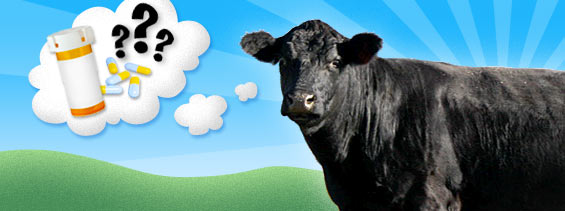
Hormones are used to boost “feed efficiency” and milk production in cows.
Perhaps the most familiar to consumers is the hormone rBST (aka recombinant bovine somatropin, “artificial growth hormone”) which is administered to some dairy cows to increase the amount of milk they produce. rBST is an artificially produced version of a hormone naturally produced by cows.
The safety of rBST use and its effect on produced milk is the subject of ongoing debate. Use of rBST in dairy production is currently legal in the US and considered safe by the FDA, but illegal in many other countries. Because of public outcry, some dairy producers do not use rBST and label their products “milk from cows not treated with rBST.”
However, rBST is not the only hormone used. The use of estrogen & trenbolone acetate (TBA) is quite common in the beef cattle industry. They are typically administered through timed-release pellets injected into the back of the ear. The back of the ear is the legally required implant site as ears are removed during slaughter, preventing the implants from directly entering the food supply (Zobell, 2000). Some feed lots include additional synthetic estrogen in their feed blend (Pollan, 2002).
Estrogen alone can increase feed efficiency by 5-10%, as much as 8-15% when used together with TBA which, in addition to helping cattle bulk up more, “decreases the normal loss of muscle tissue in sedentary animals” (Zobell, 2000). The financial return on use of these implants is significant, offering a return of $5-$10+ worth of meat per dollar spent on grain (Zobell, 2000). Michael Pollan writes “an implant costs $1.50 and adds between 40 and 50 pounds to the weight of a steer at slaughter, for a return of at least $25” (Pollan, 2002).
It is worth noting that one aspect of both estrogen and TBA’s bulking up effects is their ability to increase the circulating levels of insulin-like growth factor-1 (IGF-1), a hormone (Zobell, 2000), and that opponents of rBST use in dairy cows cite increased IGF-1 levels in the resulting milk as a possible health concern (Scientific Committee on Veterinary Measures Relating to Public Health, 1999).
Administering hormones to cattle does result in measurable residues occurring in the finished meat. While the FDA regards these residues as being at safe levels, some scientists are concerned that estrogenic buildup in the environment (perhaps through consumption of the meat or introduced to the environment through feedlot waste) may be leading to negative effects on fish living downstream of feedlots and possibly even human beings (Pollan, 2002).
Works Cited
Pollan, M. (2002, March 31). Power Steer. Retrieved October 31, 2011, from Michael Pollan.com (previously published in NY Times Magazine): http://michaelpollan.com/articles-archive/power-steer/
Scientific Committee on Veterinary Measures Relating to Public Health. (1999, March 15-16). Report on Public Health Aspects of the Use of Bovine Somatotrophin. Retrieved October 31, 2011, from Europa – Official Website of the European Union: http://ec.europa.eu/food/fs/sc/scv/out19_en.html
Zobell, C. H. (2000, August). Beef Cattle Implants (Utah State University Publication). Retrieved October 31, 2011, from Sustainable Table: http://www.sustainabletable.org/issues/docs/Utah_University_Implants.pdf


